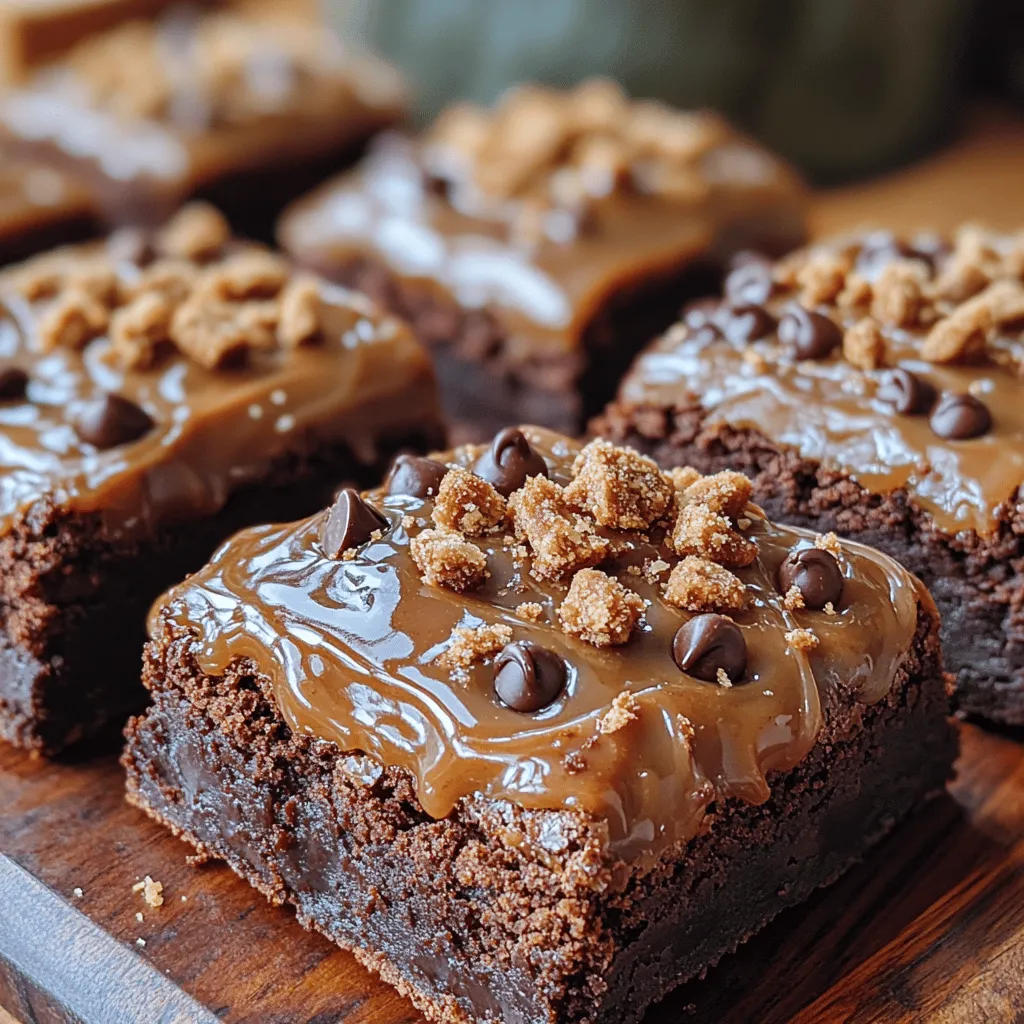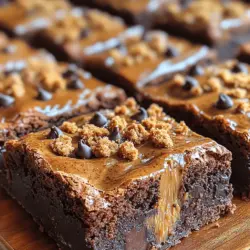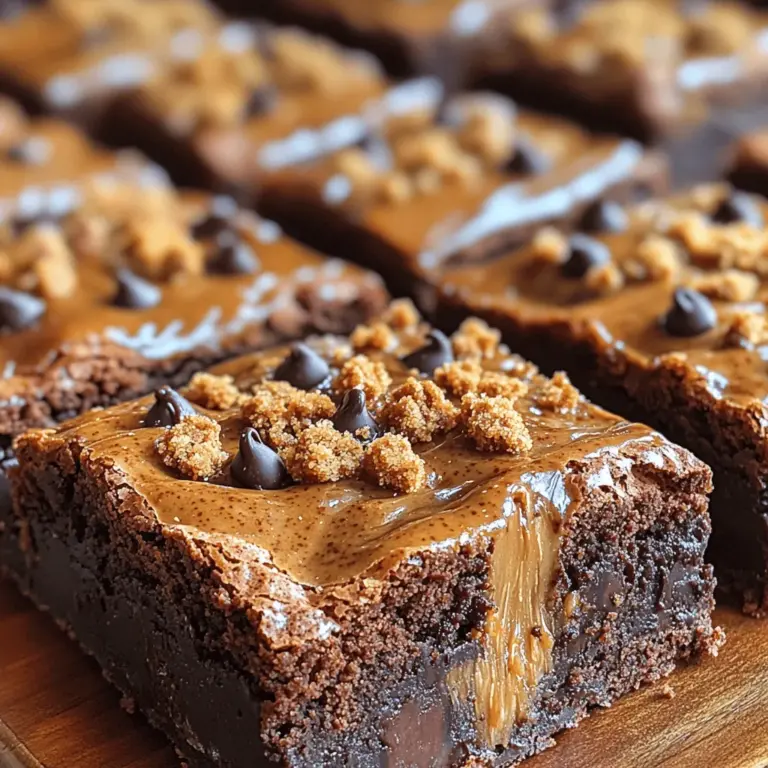Indulging in the rich, velvety goodness of brownies is a beloved ritual for many dessert lovers. The aroma of freshly baked brownies wafting through the kitchen can evoke nostalgia, warmth, and sheer joy. As classic as brownies are, there’s always room for innovation, and this is where our Biscoff Cookie Butter Brownies step into the spotlight. This recipe elevates traditional brownies with the creamy, spiced flavors of Biscoff cookie butter, creating a delectable treat that satisfies both chocolate cravings and a longing for something unique.
Imagine biting into a fudgy brownie with a deep chocolate flavor, only to be met with the warm, spiced notes of Biscoff cookie butter. The combination is pure magic, making these brownies an irresistible dessert for any occasion. Whether you are hosting a gathering, looking for a special treat to enjoy at home, or simply want to impress your friends and family with a one-of-a-kind dessert, these brownies are sure to hit the mark.
In this article, we will explore every aspect of making Biscoff Cookie Butter Brownies, from understanding the key ingredients that contribute to their irresistible taste and texture to perfecting the baking process. Each step is designed to ensure your brownies come out moist, rich, and packed with flavor. Let’s dive right in!
Understanding the Key Ingredients
The foundation of any great brownie lies in its ingredients. For our Biscoff Cookie Butter Brownies, each component plays a crucial role in achieving that perfect balance of flavor and texture. Here, we break down the essential components that make these brownies so irresistible.
Unsalted Butter: The Base of Richness
Butter is a star player in any brownie recipe, and for good reason. It contributes to the rich flavor and fudgy texture that we all love. Unsalted butter is the preferred choice because it allows for better control over the sweetness of the final product. When you use unsalted butter, you can adjust the amount of salt in your recipe to suit your taste, ensuring that the brownies are perfectly balanced. Moreover, the fat in butter helps to create a moist and tender crumb, which is essential for achieving that melt-in-your-mouth brownie experience.
Sugars: Balancing Sweetness and Moisture
Sugar is another critical ingredient that affects the texture and taste of brownies. In this recipe, we will use a combination of granulated sugar and brown sugar. Granulated sugar contributes to the overall sweetness and helps create a slight crisp on the top of the brownies, while brown sugar adds moisture and depth of flavor due to its molasses content. This combination results in brownies that are not only sweet but also have a chewy, fudgy texture. The contrast between the two types of sugar is what makes these brownies truly special, enhancing both the taste and mouthfeel.
Eggs: Binding and Leavening Agents
Eggs are more than just a binding agent; they also act as leavening agents in brownie recipes. They provide structure and stability, ensuring that the brownies hold their shape while baking. The proteins in eggs coagulate when heated, creating a dense yet tender texture. For the best results, it’s important to incorporate the eggs properly. Whisking them together before adding them to the batter can help incorporate air, leading to a lighter brownie. Additionally, using room temperature eggs allows for better mixing, ensuring a uniform batter.
Biscoff Cookie Butter: The Star Ingredient
Now, let’s talk about the star of the show—Biscoff cookie butter. This creamy spread, made from crushed Biscoff cookies, is what sets these brownies apart. It has a unique flavor profile that combines notes of caramel, brown sugar, and warm spices, making it the perfect complement to chocolate. Its velvety texture not only enhances the flavor but also contributes to the moistness of the brownies. When baked, the Biscoff cookie butter melts into the brownie batter, creating pockets of spiced goodness that are simply irresistible. If you haven’t tried Biscoff cookie butter yet, you are in for a delightful surprise!
Cocoa Powder: For That Rich Chocolate Flavor
Cocoa powder is essential for achieving that deep chocolate flavor that brownies are known for. When selecting cocoa powder, you have the option of using either natural or Dutch-processed cocoa. Natural cocoa powder has a stronger flavor and contributes to a lighter color, while Dutch-processed cocoa gives a milder flavor and darker color due to its alkalization process. For this recipe, you can use either type, but keep in mind that the flavor intensity and color may vary slightly. Whichever you choose, cocoa powder is what brings that rich chocolate essence to these brownies.
Flour and Baking Powder: Creating the Right Structure
Flour is another key ingredient that affects the density of brownies. All-purpose flour is typically used in brownie recipes, as it provides the right amount of structure without making them too cake-like. The gluten formed during mixing helps to bind the ingredients together, contributing to the chewy texture we love. Additionally, a small amount of baking powder is included to provide a slight lift, preventing the brownies from becoming overly dense. It’s important to measure the flour accurately, as too much can lead to dry brownies.
Chocolate Chips and Crushed Cookies: Adding Texture and Flavor
To take these brownies to the next level, we will fold in chocolate chips and crushed Biscoff cookies into the batter. Chocolate chips add bursts of rich chocolate flavor, melting beautifully as the brownies bake. You can use semi-sweet, dark, or even milk chocolate chips, depending on your preference. The crushed Biscoff cookies not only enhance the flavor but also provide a delightful crunch that contrasts with the fudgy brownie texture. This combination of ingredients creates a multi-layered brownie experience that is sure to impress.
Preparing the Brownies: Step-by-Step Guide
A successful brownie requires careful attention to the preparation process. Here, we will provide a detailed walkthrough of each step to ensure your brownies turn out perfectly every time.
Prepping Your Equipment and Ingredients
Before you dive into making your Biscoff Cookie Butter Brownies, it’s crucial to prep your equipment and ingredients. Start by preheating your oven to 350°F (175°C). Preheating is an essential step, as it ensures that your brownies bake evenly. While the oven is heating up, prepare your baking pan. Line an 8×8-inch square pan with parchment paper, leaving some overhang for easy removal later. This simple step will make your cleanup process a breeze and help prevent the brownies from sticking.
Next, gather and measure out all your ingredients beforehand. Accurate measurements are vital for achieving the best results in baking. Use a kitchen scale for precision, especially when it comes to flour and sugar. Having everything ready will streamline the process and help you focus on creating the perfect brownie batter.
Melting the Butter: Achieving the Perfect Consistency
The first step in making these delicious brownies is to melt the unsalted butter. You can do this in a microwave-safe bowl or over the stovetop using a double boiler. If using the microwave, heat in short intervals, stirring in between, until the butter is completely melted. Be careful not to overheat, as this can lead to separation or burning.
Once melted, let the butter cool slightly before mixing it with the sugars. The warmth of the butter will help dissolve the sugars, creating a smooth, glossy batter. This step is crucial, as it sets the stage for the fudgy texture we’re aiming for. After the butter has cooled, add the granulated sugar and brown sugar, stirring until the mixture is well combined and smooth. The sugars should be fully incorporated into the melted butter, creating a luscious base for your brownie batter.
With the foundation set, we’re ready to move on to the next steps that will bring our Biscoff Cookie Butter Brownies to life. Stay tuned as we dive deeper into the mixing process and the magic that happens as we combine our remaining ingredients!

Ideal Techniques for Melting Butter Without Browning It
Melting butter is a fundamental step in many brownie recipes, including our Biscoff Cookie Butter Brownies. To achieve the perfect melt without browning, consider using these techniques:
1. Gentle Heat: Always melt butter over low heat. This prevents the milk solids from browning too quickly. If you’re using a stovetop, keep the burner on low, and stir the butter frequently to distribute the heat evenly.
2. Microwave Method: If you prefer a quicker method, use the microwave on a low power setting. Place the butter in a microwave-safe bowl, cover it loosely with a microwave-safe lid or paper towel, and heat in 10-15 second intervals, stirring in between until fully melted.
3. Double Boiler: This technique is ideal for maintaining control over the temperature. Fill a pot with a few inches of water and bring it to a simmer. Place a heatproof bowl on top (ensuring it doesn’t touch the water) and add the butter. Stir gently until melted.
Why the Temperature of the Melted Butter Matters in the Recipe
The temperature of the melted butter is crucial for the overall texture of your brownies. If the butter is too hot when mixed with sugars, it can cook the sugars, resulting in a grainy texture. Conversely, if the butter is too cool, it may not incorporate well with the sugars, leading to uneven mixing. Aim for a warm, but not hot, melted state—just enough to feel warm to the touch but not steaming. This balance ensures a smooth and creamy mixture, which is essential for achieving that fudgy brownie texture we all adore.
Mixing the Sugars: Creating a Flavorful Base
Once your butter is perfectly melted, it’s time to mix in the sugars for that rich, sweet base.
1. Techniques for Ensuring the Sugars Are Well Combined with the Butter: Pour the melted butter into your mixing bowl and add both granulated and brown sugars. Using a whisk or an electric mixer at a low speed, mix the sugars into the butter until it forms a smooth, glossy paste. This process not only combines the ingredients but also helps to dissolve the sugars, resulting in a tender brownie.
2. Tips on Cooling the Mixture Before Adding Eggs: Allow the butter-sugar mixture to cool slightly before adding the eggs. If you add eggs to a mixture that is too hot, they may cook, leading to scrambled eggs in your batter. Ideally, let the mixture cool for about 5-10 minutes until it is warm but not hot. You can test this by touching the bowl; it should feel warm but not uncomfortable.
Incorporating Eggs and Vanilla: Enhancing Flavor
Adding eggs and vanilla is a vital step in building the flavor profile of your brownies.
1. The Significance of Adding Eggs One at a Time: Incorporating eggs one at a time ensures they are thoroughly mixed into the batter. This gradual addition helps maintain a smooth consistency and allows each egg to emulsify properly before the next is added, resulting in a more uniform texture.
2. How Vanilla Extract Complements the Other Flavors: Vanilla extract is more than just a flavor enhancer; it helps to round out the sweetness of the sugars and balances the richness of the butter and eggs. Use pure vanilla extract for the best flavor, adding it along with the first egg for maximum integration with your batter.
Combining Dry Ingredients: Ensuring Even Distribution
The next step involves preparing your dry ingredients and incorporating them into the wet mixture.
1. Importance of Sifting Dry Ingredients to Avoid Lumps: To ensure your brownies have a smooth texture, sift together the all-purpose flour, cocoa powder, baking powder, and salt in a separate bowl. Sifting breaks up any clumps and aerates the flour, leading to a lighter brownie.
2. Techniques for Combining Wet and Dry Ingredients Without Overmixing: When combining the dry ingredients with the wet mixture, use a rubber spatula or wooden spoon to gently fold the dry ingredients into the wet. Do this until just combined, being careful not to overmix. Overmixing can develop the gluten in the flour, resulting in tougher brownies. The batter should be slightly lumpy, with no visible flour remaining.
Folding in Biscoff Cookie Butter and Chocolate Chips: The Final Touch
Now comes the moment of truth where you add the star ingredients to your brownie batter.
1. How to Properly Fold in Ingredients to Maintain a Light Texture: With the dry ingredients incorporated, gently fold in the Biscoff cookie butter and chocolate chips using the same folding technique. Start by adding half of the cookie butter, mixing until combined, then add the remaining half along with the chocolate chips. This method ensures that both additions are evenly distributed without deflating your batter.
2. Suggestions for Adjusting the Amount of Cookie Butter or Chocolate Chips: Depending on your preference, you can adjust the amount of Biscoff cookie butter for a stronger flavor or increase the chocolate chips for extra richness. If you’re feeling adventurous, consider adding a sprinkle of crushed Biscoff cookies on top before baking for added texture.
Baking the Brownies to Perfection
With your batter prepared, it’s time to bake those brownies to perfection.
The Baking Process: Time and Temperature
1. Importance of Maintaining the Right Temperature: Preheat your oven to 350°F (175°C). Baking at the correct temperature is crucial for achieving the perfect rise and texture. An oven thermometer can help ensure your oven is calibrated correctly.
2. Recommended Baking Times and Signs of Doneness: Pour the brownie batter into a greased or parchment-lined baking pan, smoothing it out evenly. Bake for 25-30 minutes, checking for doneness around the 25-minute mark. Insert a toothpick into the center; it should come out with a few moist crumbs, but not wet batter. If it comes out clean, your brownies may be overbaked, leading to a dry texture.
Cooling the Brownies: Why Patience is Key
Patience is essential after baking, as cooling your brownies correctly will enhance their flavor and texture.
1. Explanation of Why Cooling is Essential for Achieving the Right Texture: Allow the brownies to cool in the pan for about 10-15 minutes before transferring them to a wire rack. Cooling allows the brownies to firm up, making them easier to cut and enhancing their fudgy consistency.
2. Best Practices for Cooling Brownies: After the initial cooling time, gently lift the brownies out of the pan using the parchment paper (if used) and let them cool completely on a wire rack. This prevents sogginess and ensures that the bottom doesn’t become overly moist.
Serving Suggestions and Variations
Biscoff Cookie Butter Brownies are versatile and can be enjoyed in various delightful ways.
Serving the Brownies: Presentation Matters
1. Ideas for Plating and Garnishing Brownies for Special Occasions: For a stunning presentation, cut the brownies into squares and arrange them on a serving platter. Consider dusting them with powdered sugar or drizzling with additional Biscoff cookie butter for an elegant touch. Adding a scoop of vanilla ice cream on the side can elevate the dessert experience.
2. Optional Toppings Like Drizzles of Biscoff Cookie Butter: A simple yet effective way to enhance your brownies is by drizzling melted Biscoff cookie butter over the top just before serving. This not only adds visual appeal but also intensifies the Biscoff flavor, making for a decadent treat.
Variations on the Classic Recipe
1. Suggestions for Incorporating Other Ingredients, Such as Nuts or Different Types of Chocolate: Feel free to get creative with your brownies. Chopped nuts like walnuts or pecans can add a delightful crunch. You can also swap half of the chocolate chips for white chocolate or milk chocolate for a different flavor profile.
2. Exploring Gluten-Free or Vegan Adaptations of the Recipe: For a gluten-free version, substitute all-purpose flour with a gluten-free flour blend. For a vegan adaptation, replace the eggs with flax eggs (1 tablespoon of ground flaxseed mixed with 2.5 tablespoons of water per egg) and use a dairy-free butter alternative. Keep in mind that while modifications may alter the texture slightly, they can still yield delicious results.
Conclusion
Biscoff Cookie Butter Brownies are a delightful fusion of flavors and textures that will please any dessert lover. By following this comprehensive guide, you can create a batch of brownies that not only satisfies your sweet tooth but also impresses your friends and family. With the right techniques and a touch of creativity, these brownies will become a cherished recipe in your baking repertoire. Enjoy the process, and most importantly, savor every bite!

